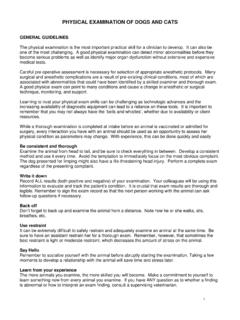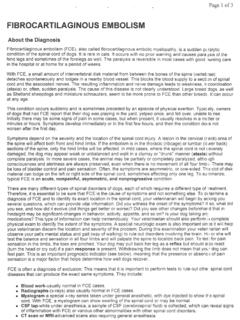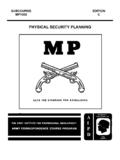Transcription of Cushing’s Disease (Hyperadrenocorticism)
1 SYMPTOMSC ushing s Disease occurs primarily in senior dogs. It may also occur in ferrets. Signs that owners may notice in a pet with cushing s Disease include increased urination, excessive thirst, voracious appetite, weight gain, thin hair coat, pot-bellied appearance, chronic infections, panting, and lack of energy. The symptoms observed in animals suffering from cushing s Disease stem from an increased secretion of the body s stress hormone, cortisone. Cortisone is released from the adrenal glands, glands that overlay the kidneys in the abdomen. In 15% of dogs with cushing s Disease , there exists a tumor in one or both of the adrenal glands.
2 The tumor cells produce an excessive amount of cortisone, resulting in symptoms. In 85% of dogs with cushing s Disease , a benign tumor in the pituitary gland at the base of the brain is the cause. The pituitary gland, the master gland , also regulates the function of other endocrine glands in the body. DIAGNOSISThe first steps in diagnosing cushing s Disease are obtaining a good history and a thorough physical exam. The veterinarian will recommend comprehensive blood work and a urinalysis to help eliminate the possibility of other metabolic diseases such as diabetes, kidney failure, and inadequate thyroid gland function.
3 Next, the veterinarian may recommend a blood test called an ACTH stimulation test, or LDDS (Low Dose Dexamethasone Suppression) test. These two tests are hormone tests that challenge the adrenal gland. An over-productive adrenal gland responds quite differently than a normal adrenal gland in the face of ACTH or dexamethasone a pet tests positive for cushing s Disease , the next step is to determine whether it is an adrenal gland tumor or a pituitary gland tumor. An abdominal ultrasound performed by a board certified veterinary radiologist may be scheduled. If no discreet tumor is located in either adrenal gland, it is assumed by default that the pet has a pituitary gland tumor.
4 TREATMENTThe treatment options regarding cushing s Disease are numerous. In pets with adrenal gland tumors, surgical removal is the preferred method of treatment. However, if a pet owner is fearful of the complications and risks involved with surgical intervention, medical therapy is an option. In dogs with pituitary tumors, surgery is not a treatment. There are several choices for medically managing cushing s Disease . The option with the most positive, long-term results is the use of a drug called Lysodren. Lysodren is a medication that destroys adrenal gland tissue. Side effects associated with the use of Lysodren include weakness, loss of appetite, vomiting and/or diarrhea, and/or a loss of balance.
5 The drug is initially given twice daily with meals. When the dog s appetite begins to wane, the twice a day therapy is discontinued. This usually takes between 5-7 days. Seven to ten days after the onset of therapy, an ACTH stimulation test is performed to see if the therapy was effective. The dog is then put on a twice weekly maintenance dose of Lysodren. An ACTH stimulation test is performed one month later, and then every three months for the life of the dog. A second option for medical management of cushing s Disease is the use of a drug called Anipryl. Anipryl is only recommended for dogs with pituitary dependent cushing s Disease , not for adrenal gland tumors.
6 Anipryl is recommended for cushing s Disease cases that are uncomplicated by other metabolic diseases, such as diabetes, liver Disease , etc. Anipryl is safe and carries few side effects. It is given in tablet form once daily. It is helpful in alleviating the symptoms of cushing s Disease 20-30% of the time, but it is NOT a Vance Drive | Arvada, CO 80003 | (303) 420-4422 cushing s Disease (Hyperadrenocorticism)A third option for treating cushing s Disease is the use of a drug called ketoconazole. Side effects include loss of appetite, vomiting/diarrhea, and liver Disease .
7 Ketoconazole is given orally twice daily. After seven to ten days, an ACTH stimulation test is recommended to make sure that adrenal gland function is normal. If the adrenal gland function is normal, a maintenance dose of ketoconazole can be calculated. Most pets with cushing s Disease should be put on a diet that is low in fat and/or protein, and easy to digest. These animals are generally obese and have secondary liver problems. Consult with your veterinarian for recommendations regarding your particular dog s dietary needs. MONITORINGM onitoring of patients with cushing s Disease varies widely, depending upon the course of therapy followed.
8 For surgical patients the immediate postoperative period may require hospitalization and frequent recheck appointments, as well as a two-week postoperative ACTH stimulation test. For patients undergoing Lysodren therapy, an exam and ACTH stimulation test is recommended prior to beginning the therapy, and at one week, one month, and every three months thereafter. For Anipryl therapy, recheck exams and evaluations are recommended after one month, and every three months thereafter. For ketoconazole therapy, an exam, chemistry profile, and ACTH stimulation test is recommended at one week, one month and every three months costs for an examination, comprehensive blood work and urinalysis run about $300.
9 The cost of an ACTH stimulation or LDDS test is approximately $200. The cost of an abdominal ultrasound is about $350. The cost of surgical removal of an adrenal gland tumor varies, depending upon the size of the tumor and whether or not the tumor invades surrounding tissues. An owner could expect a range of between $2,500-5,000. The cost of a 3-month supply of Lysodren for a 25 lb. dog is around $ The cost of Anipryl for a 25 lb. dog for one month is $ The cost for a 3-month supply of ketoconazole for a 25 lb. dog is $25-45, depending upon the necessary maintenance dose.
10 In summary, for the first year of diagnosis, treatment, and monitoring of a dog with cushing s Disease , using the Lysodren therapy protocol, a pet owner can expect an expense of $2,200-2,500. For the first year of cushing s Disease therapy using Anipryl, the expected expense is $1,750-2,000. Please speak with your veterinarian if you have questions regarding cushing s Disease in your pet. 7778 Vance Drive | Arvada, CO 80003 | (303) 420-4422








